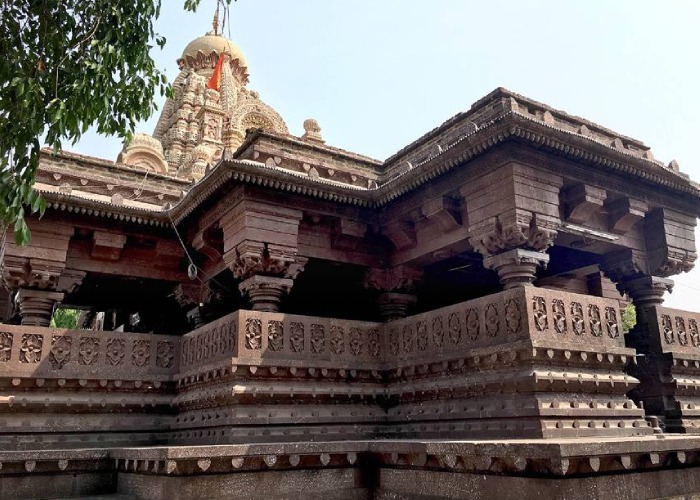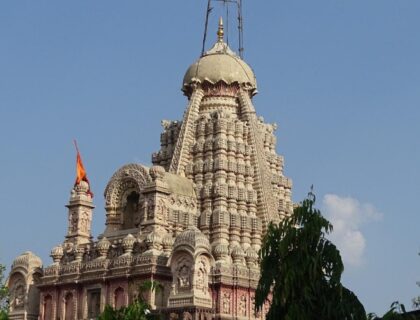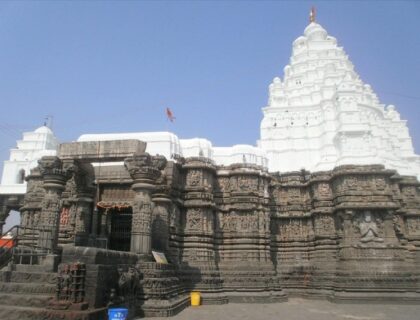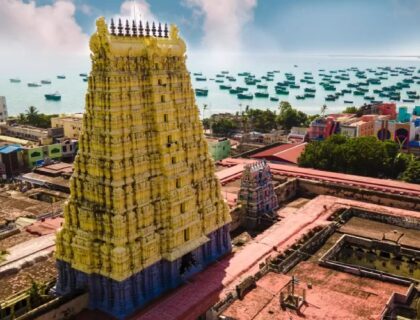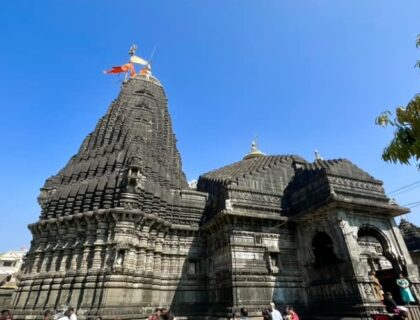Grishneshwar Jyotirling
Grishneshwar Jyotirling Mandir or Grushneshwar Temple is one of Bhagwan Bholenath’s 12 Jyotirlinga Temples located in Verul village of Sambajinagar district, Maharashtra, India. This temple is located near the Ellora Caves. Grishneshwar means Lord of compassion. It is located in Ellora near Daulatabad in Maharashtra, India.
The Padma Purana and the Shiva Purana both make mention of this temple. The Islamic invading force damaged this temple during Invasions in India and vandalized this temple, which was later rebuilt. The indigenous Naga tribes are thought to have settled in this temple. The highly sacred Yelaganga River flows near this temple. The river is considered extremely sacred.
The story behind Grishneshwar Jyotirling
According to legend, there was a Brahmin named Brahmavetta Sudharm who lived in the Devagiri mountains with his wife Sudeha. Sudeha got her sister Ghushma married to her husband because the couple was childless. Ghushma would make lingas, worship them, and immerse them in the nearby lake on the advice of her sister. She was finally blessed with a son. Sudeha grew jealous of her sister and murdered her son, throwing him into the lake where her sister would immerse the lingas.

Despite the fact that Ghushma’s daughter-in-law informed her that Sudeha had a hand in her son’s murder, Ghushma continued her daily rituals with complete faith in the Lord’s mercy. And, true to her beliefs, she saw her son approaching her as she went to immerse the linga. Lord Shiva appeared in front of her and informed her of her sister’s heinous crime.
Ghushma begged God to forgive her sister. The Lord, pleased, granted her a boon. She asked him to remain in that location, which is why he manifested himself as Ghushmeshwar, a jyotirlinga. Shivalaya was the name of the lake in which Ghushma immersed the lingas.
History of Grishneshwar Jyotirling
The temple structure was destroyed by the Delhi Sultanate in the 13th and 14th centuries. During the Mughal-Maratha conflict, the temple was rebuilt several times before being destroyed again. The temple was re-constructed by Maloji Bhosale of Verul, (grandfather of Chhatrapati Shivaji Maharaj) in the 16th century. After the fall of the Mughal Empire, it was rebuilt in the 18th century under the guidance of Queen Ahilyabai Holkar of Indore.

It is now an important and active Hindu pilgrimage site, attracting long lines of devotees on a daily basis. Anyone can enter the temple grounds and inner chambers, but men must enter the temple’s sanctum sanctorum core (Garbha-Griha) bare-chested, according to local Hindu tradition.
Architecture of Grishneshwar Jyotirling
The Grushneshwar Jyotirlinga Mandir is constructed of black stone on a 44,000 sq ft area and features numerous sculptures and fine designs on its interior and exterior walls. A Jyotirlinga murti can be found in the mandir’s Garbhgruh, and a large murti of Shivaji’s favourite Bhakt Nandi can be found in front of the main door. The temple was restored three times, the first time by Maloji Bhosale, Shivaji’s grandfather, in the 16th century. The current temple, which was built in 1730 by Malhar Rao Holkar’s wife Gautami Bai Holkar and later restored by Ahilyabai Holkar, was the last major restoration work completed.
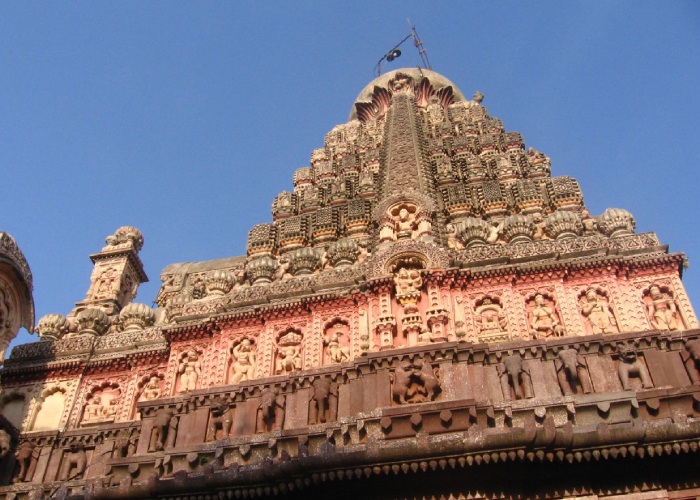
The shikara, or spire, of the red rock temple has five levels. You can see the Dashavatars (ten symbols) of Lord Vishnu carved in red stone. On the 24 pillars of the court hall, you’ll find carvings of Lord Shiva from various stories and legends. The sanctum houses the east-facing linga. There is also a statue of Nandi, Lord Shiva’s mount, in the court hall.
Facts about Grishneshwar Jyotirling
- The Grishneshwar Jyotirling is a nationally protected site located one and a half kilometres from the Ellora Caves, a UNESCO World Heritage Site. It is 30 kilometres north-west of Sambhaji Nagar and 300 kilometres east-northeast of Mumbai.
- Grishneshwar Jyotirling is also called Ghushmeshwar and Kusumeshwar.
- Grushneshwar Jyotirling is one of the 12 Jyotirling Temples of the Hindu religion, It is mentioned in Shivapuran, Skandpuran, Ramayan and Mahabharata.
- It is believed that Lord Shiva himself visited these places and hence they have a special place in the hearts of devotees.
- The Grishneshwar Jyotirling Temple was destroyed by the Mughal Invader in the 13th-14th centuries AD. In the 16th century AD, Maratha ruler Shivaji’s grandfather, Maloju Bhisale of Verul, reconstructed the temple.
- The sanctum sanctorum includes Lord Grishneshwar and his consort Grishneshwari.
- The temple is significant because pilgrims believe that by visiting the Grishneshwar temple, they can reap the benefits of worshipping all 12 Jyotirlingas. The Grishneshwar temple is also said to be a classic example of pre-historic architecture with beautiful carvings.
- Men are required to go bare-chested into the temple.
- In the temple murals and carvings, devotees can see the Lord and his consort’s marriage scene. The Grishneshwar temple also has a well from which holy water flows.
Famous Festivals In Grishneshwar Jyotirling
- Mahashivaratri: The Maha Shivaratri festival is a grand event at Grishneshwar temple, as it is at all important Shiva temples. It is the main festival in town. Every year, millions of devotees flock to this town to catch a glimpse of the Lord on this auspicious day, which falls in February/March.
- Ganesh Chaturthi: Dedicated to Lord Ganesh, this festival is celebrated in August / September
- Durga Puja. (Winter) – Devotees celebrate Navaratri at this temple in the month of Ashwin (Sep-Oct) as well as celebrate the triumph of the Goddess Durga over the buffalo demon (Mahishasura).
- Navaratri. (Summer) – They celebrate other Navaratri in the fortnight of the Chaitra (March-April). Every nine days they worship Navadurga (nine Durgas).
How to Reach Grishneshwar Jyotirling
You can go to this spiritual location at any time of the year, it’s best to go there in the winter, between October and March. During Mahashivratri, a devotee’s ultimate treat would be to visit this divine and ancient location!
By Air: Chhatrapati Sambhaji (Aurangabad) Airport is a nearby Airport and it is nearly 37 kilometres from Grishneshwar Jyotirling.
By Rail: Chhatrapati Sambhaji Nagar (Aurangabad) Railway Station is near the Railway Station and is nearly 29 kilometres from Grishneshwar Jyotirling Temple.
By Road: Chhatrapati Sambhaji Nagar (Aurangabad) is well connected to most of the cities. Local transport is available in plenty.
Also Read – Trimbakeshwar Jyotirlinga
Location
Facilities
- Drinking Water
- Pooja Item Shops
- Prasad Shops
- Restaurants Nearby
- Resting Room


